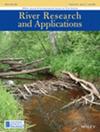评估圣胡安河猪背引水渠中幼鱼的夹带情况
IF 1.9
4区 环境科学与生态学
Q4 ENVIRONMENTAL SCIENCES
引用次数: 0
摘要
世界各地的引水工程都可能诱捕或撞击鱼类,对鱼类种群造成影响,但鱼筛等屏障可以减少此类威胁。在美国圣胡安河(San Juan River),由于沉积物和碎屑较多,传统的屏障不起作用,因此北卡罗来纳州的猪背引水渠(Hogback Diversion Canal)采用了新颖的堰墙设计,以减少亚成体和成鱼的缠绕。我们采用实验和隔夜试验相结合的方法,评估了堰墙在减少幼鱼夹带方面的效果。我们比较了向灌溉者供水并随后夹带鱼类的灌溉渠与将水和鱼类输送回河流的旁路渠之间的幼鱼密度。试验期间,在灌溉渠中收集到的孵化生产的幼鱼密度(0.74 条/立方米)是在旁通渠中收集到的幼鱼密度(1.43 条/立方米)的 52%,这表明夹带减少了。隔夜试验期间野生幼虫的密度表明,灌溉渠和旁通渠的捕获率、发育阶段和采样日期之间存在一些微小差异,但大多不显著。虽然野生幼虫的夹带率没有显著降低,但折叠后中极幼虫和金属幼虫的密度差异表明,发育较成熟的本体阶段的夹带率可能会降低。有必要开展更深入的研究,以更好地阐明新型堰壁在减少幼鱼夹带方面的功效。不过,我们对幼鱼的研究结果以及之前对大型鱼类的夹带研究结果表明,新型堰墙可能会减少引水过程中的鱼类夹带,并有利于那些无法采用传统筛网的河流生态系统。本文章由计算机程序翻译,如有差异,请以英文原文为准。
Assessing entrainment of larval fish in the Hogback Diversion Canal, San Juan River
Water diversions worldwide may entrain or impinge fish and have population-level impacts, but barriers like fish screens can reduce such threats. Traditional barriers are ineffective in the San Juan River, USA, due to high sediment and debris loads, so the Hogback Diversion Canal, NM, employs a novel weir wall design to reduce entrainment of sub-adult and adult fishes. We evaluated the effectiveness of the weir wall in reducing the entrainment of larval fish using a combination of experimental and overnight trials. Larval fish densities were compared between the irrigation canal that delivers water to irrigators and subsequently entrains fish and the bypass canal that conveys water and fish back to the river. The density of hatchery-produced larval fish collected in the irrigation canal during the experimental trial (0.74 fish/m3) was 52% of their density in the bypass canal (1.43 fish/m3), suggesting entrainment reduction. The density of wild-produced larvae during overnight trials indicated some minor, mostly nonsignificant, differences between catch rates in irrigation and bypass canals, ontogenetic phases, and sampling dates. Though entrainment rates of wild-produced larvae were not significantly reduced, density differences among postflexion mesolarvae and metalarvae suggest possible entrainment reduction of more developed ontogenetic phases. More intensive research is necessary to better elucidate the efficacy of the novel weir wall for reducing the entrainment of larval fish. However, our larval fish results and the results from prior large-bodied entrainment studies suggest the novel weir wall may reduce fish entrainment in water diversions and benefit fluvial ecosystems in which traditional screens are unfeasible.
求助全文
通过发布文献求助,成功后即可免费获取论文全文。
去求助
来源期刊

River Research and Applications
环境科学-环境科学
CiteScore
4.60
自引率
9.10%
发文量
158
审稿时长
6 months
期刊介绍:
River Research and Applications , previously published as Regulated Rivers: Research and Management (1987-2001), is an international journal dedicated to the promotion of basic and applied scientific research on rivers. The journal publishes original scientific and technical papers on biological, ecological, geomorphological, hydrological, engineering and geographical aspects related to rivers in both the developed and developing world. Papers showing how basic studies and new science can be of use in applied problems associated with river management, regulation and restoration are encouraged as is interdisciplinary research concerned directly or indirectly with river management problems.
 求助内容:
求助内容: 应助结果提醒方式:
应助结果提醒方式:


